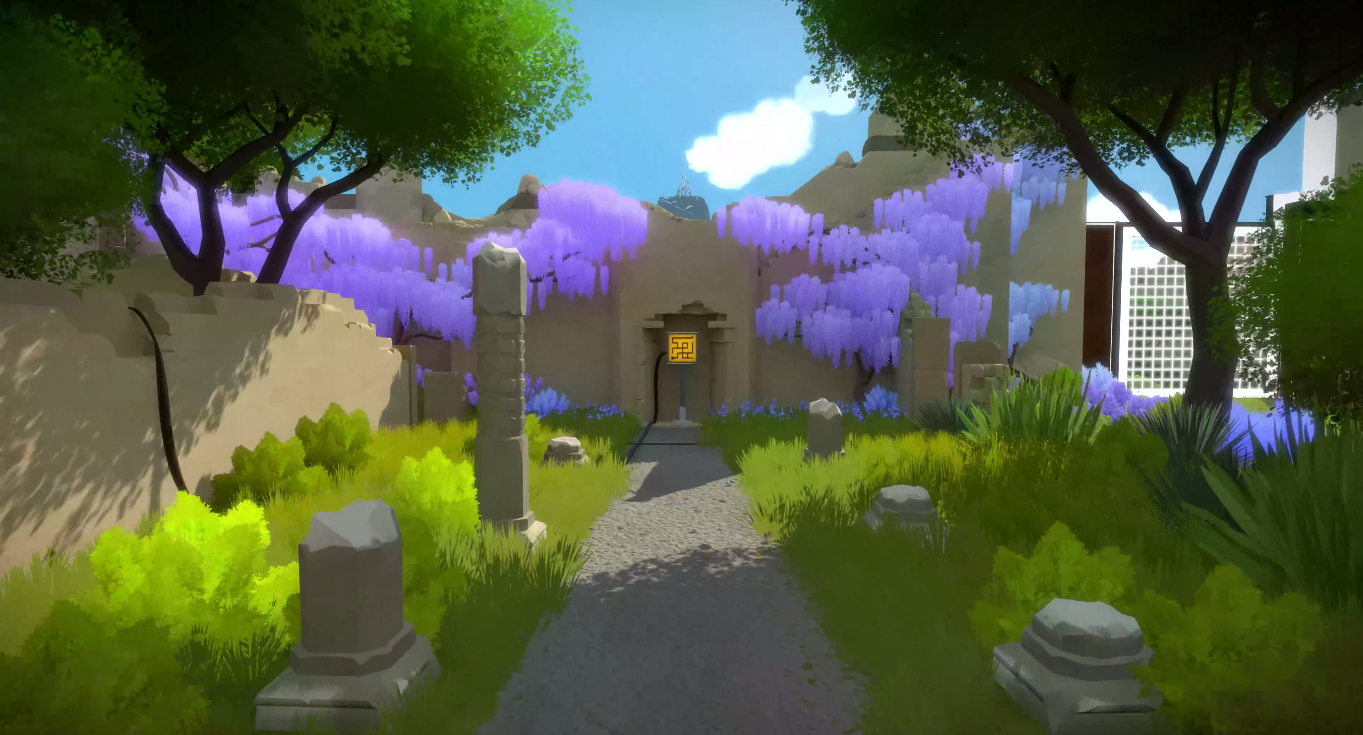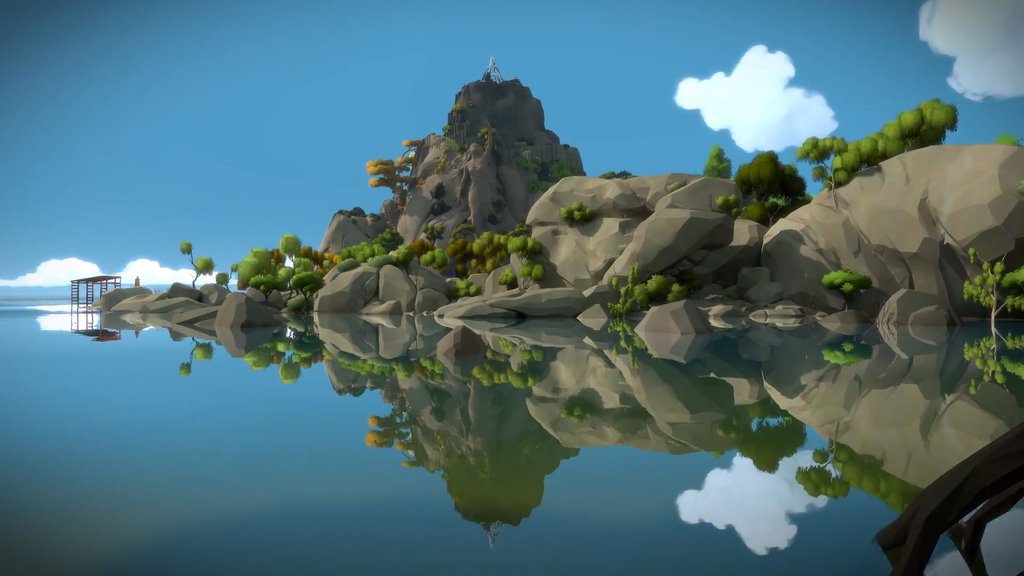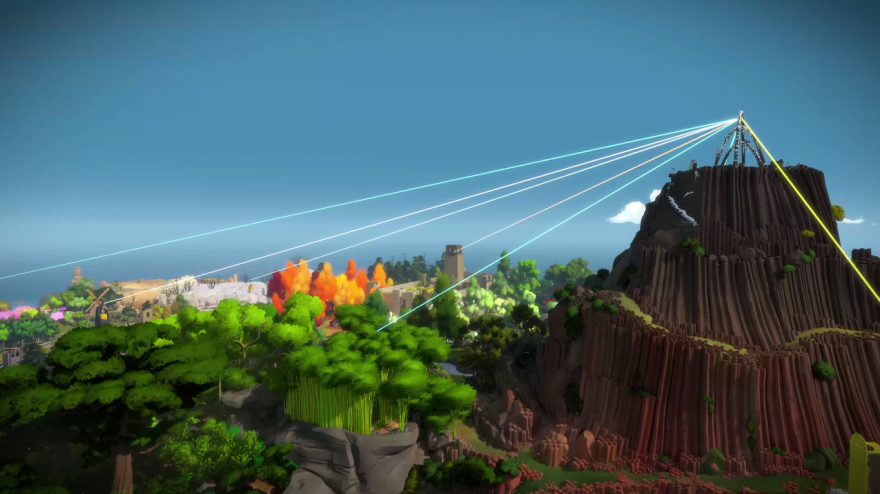When I played a demo version of The Witness at a Sony event in 2013, I was offered two approaches: 1) I could be lead through a basic tutorial of the way the game’s puzzle systems work, or 2) I could be left to wander around the island landscape and discover it at my whim. I chose the latter option, only encountered a handful of the game’s signature line-tracing puzzle panels, and spent the rest of my time gawking at the natural and architectural framework of the island. I strolled down to a seashore under a desert cliff where a voice over my shoulder assured me that the area had not been fully implemented. True enough, there wasn’t much to do except watch the waves roll in and take note of how the red stone wall of the cliff face cut into the uncompromisingly blue sky. Later I clipped through some large boulders that were supposed to form a funneling barricade leading to the entrance of a windmill. A member of the development team noted the boulder’s lack of solid form—something to fix later.
Sure enough, in the final version of The Witness, the desert shoreline contains a particularly treacherous puzzle panel and you can no longer stride through the solid rock near the windmill.
The Witness is, above all else, a designed space. And while all videogames are designed spaces in their own right, The Witness does away with the façade that it’s anything but a designed space. The island where the entirety of the game takes place is an immaculately rendered low-poly theme park of climates, topography, and eroded architecture. In less than two minutes you can run from a bamboo forest to a cherry blossom orchard to the shade of a line of palms to a dense banyan forest. Subtle transitions guide players from one temperate zone to the next, never batting an eye to justify how this could have naturally come to be. Then again, videogames have for decades teleported players from ice levels to volcano worlds and everywhere in between. This knowing and beautiful artificiality is one of the ways The Witness self-reflexively confronts what videogames historically have been. Unlike the demo event I attended, players of retail copies of The Witness are not offered a developer-lead introduction to the island. Yet the game’s pervasive emphasis on imparting the wisdom of its own design ethos, particularly through scattered audio diaries, actually diminishes the self-empowerment of its otherwise player-driven structure.
The core mode of engagement with The Witness is through line puzzles. You walk up to a brightly colored, electric panel, akin to a touchscreen kiosk, and draw a line on the presented grid that traverses a maze from start to finish. But if you’ve heard of The Witness at this point, you probably already know that. Likewise, you’re probably aware that completing puzzles typically only activates more puzzle panels, and that the simple mazes soon expand into a much more insidious chimera of all the brainteasers in your newspaper’s “Fun & Games” section. The important thing to note is that, from the start, The Witness never exactly tells you to do anything, but it does show you how its various systems work, if you know where to look. Players come to know what qualifies as successful puzzle completion through informed trial and error.

The minimalist line puzzle design reinforces the game’s devotion to player action as scientific method: test a hypothesis, observe its success or failure, and then analyze what went right and wrong. You experiment with the puzzle logic in one area, which non-diegetically unlocks the ability to comprehend secrets elsewhere that have been right under your nose for the past 20 hours. Solving puzzles in The Witness begets a genuine sense of accomplishment—you stand triumphant, wondering how that indignant blue block symbol could have stumped you for so long. You uncover more about the world, but at the same time, you’re also acutely aware that you’re making discoveries within an already known, purposefully designed space. You’re roleplaying the scientific method—practicing it in a safe, vacuum-sealed chamber.
This mentality is illustrated by the fact that you cannot walk off ledges, swim in the water, or scale inclines off the beaten path, literally mimicking the game’s stay-within-the-lines puzzle conceit. And likewise, while some puzzles explicitly incorporate physical components of the island, the puzzle design is itself an abstraction of the areas where you learn a given symbol. To give one puzzle type away, the pinwheel icon asks that when players trace other shapes on the panel, that they also cut into those drawings by one block, forming what without the pinwheel would be an insufficient path. The pinwheel ruleset is introduced in the quarry area where, if it were functional, blocks of stone would be excavated from the larger shape that is the island itself. The puzzles actually teach players about the island, and vice versa.

As if the concept of The Witness as a wholly authored environment wasn’t crystal clear already, the island is also surrounded by its own literal reflection. In the launch trailer for the game, there’s a shot of a rocky shore reaching toward the looming mountain peak. Upon further inspection, the string of half-submerged boulders reflect symmetrical mirror images in the surrounding pristine waters to form a giant, solemn human figure, hands collected in prayer. Elsewhere, in-environment puzzles require you to stand in very specific spots and look in very specific directions to catch just the right angle on an opening of sunlight breaking through the boughs to form a traceable line. Nothing is out of place. Nothing is leftover. And the game wants to make damn sure you know that.
The Witness calls for hyper-awareness from its players, as many island structures carry cloaked significance (area X is a map of area Y when seen from a height, etc.). These hidden puzzles, diagrams, and checklists are reminiscent of artist Kenneth Snelson’s “tensegrity” sculptures, particularly his 60’ tall Needle Tower installed across the street from the meticulously curated National Mall in Washington, DC. From the normal spectator’s distance, Needle Tower is an impressively sturdy spire composed of aluminum tubes that crisscross one another, almost floating in the air as they are held together solely through the tension of the cable that threads through each. It’s a marvel to consider how the sculpture stays upright. However, if viewers choose to stand under the suspended frame and look directly up, the aluminum tubes coalesce into a receding series of hexagrams, commonly read as the Jewish symbol of the Star of David. Snelson has stated that the six-pointed shape is used for structural reasons and is not meant to be symbolic of anything in particular, but that doesn’t prevent some viewers from ascribing religious significance to it.
However, while player action in The Witness often mimics the experience with Snelson’s Needle Tower, The Witness never pleads ignorance or unintention to anything it does. The island doesn’t contain hidden meaning born out of players’ interpretations so much as it contains obfuscated information, installed for explicit purpose and use. The game knows that you know that it knows that you know what it’s on about, and hides its most profound secrets far away from everyone but the most perceptive, dedicated players. Rewards bestowed for those discoveries are, by design, only particularly meaningful to players who’ve figured solutions and connections out for themselves, not resorting to guides or cheat sheets, as the payoff is often just a more difficult version of the same puzzle. To some, that may be a cruel joke, but I reveled in the strings of escalating challenges. I’ve completed every puzzle panel in the game and would love nothing more than for a Zelda-like second quest to open up with a new, rearranged set of 500+ puzzles to pour over.

I maintain this enthusiasm for The Witness’ puzzles almost in spite of the game’s dogged propensity for talking metaphysics at me via audio logs. Strewn about the island in out-of-the-way corners are pager-looking audio playback devices containing quotes and readings from various philosophers, scientists, and scholars. The readings are performed by professional voice actors, and, like everything else in The Witness, are placed specifically to relate to their immediate vicinity (in the church there’s discussion of the divine, on top of the mountain we hear about perspective, etc.). The audio logs touch on a number of topics, but taken in aggregate they verbalize various perspectives on the meaning of life, death, and belief, typically through a scientific lens. One passage by theoretical physicist Richard Feynman speaks about the value of doubt in scientific practice. This, of course, correlates to the puzzle solving notion that just because you know one rule about a puzzle system, doesn’t mean you know all of the rules.
The thing is, I actually found many of the passages to be quite interesting as general notions for contemplation, but their function in the game is disjointed and overreaching. They act like a bibliography of references and inspirations for the game, where the game is already communicating much of the same information through the rest of its astoundingly intricate design. I don’t need someone to tell me to soak in the wonders of Autumn when I’m already basking in the saturated orange glow of an October canopy.
It’s worth noting that the audio logs are totally optional, and you can get to the “end” of The Witness without ever listening to or even seeing one. But when what you do in the game is scour an island for any details that might act as clues to puzzle solutions, purposefully ignoring information isn’t truly an option. The irony is that the audio logs actually prevented me from solving puzzles in the moment, as tuning my brain to soak in all the heady talk diverted the thought-power I’d otherwise dedicate to deducing mazes. Perhaps I’d be less irked about the soundbites if they were implemented more like footnotes in practice, but as is, they—along with some secret videos—are the entire narrative hook of the game, hinting at a reveal of some grand explanation as to what is happening on this island. I speculated about who left these devices around and why. And depending on how far you dig into the post-ending areas, that reveal will either not exist or buckle under the weight of its own anticipation.
There is one secret video that is an exception to this pitfall, and it’s one of the only audio logs/videos in the game that doesn’t feel like it’s trying to get you to understand some truth by couching itself in a lecture or academic treatise. The video is the climactic final sequence from Andrei Tarkovsky’s 1983 film Nostalghia. In the wordless scene, a middle-aged man struggles to carry a lit candle from one end of a drained pool to the other without the flame extinguishing in the breeze. It’s an arduous exercise, filmed in one 9-minute continuous shot. After a couple failed attempts and restarts, the man finally sets his tiny flame down on a ledge at the far end of the pool and collapses out of frame. It’s presumed that he dies. This is a rarity in The Witness: a metaphor that leaves space, in a game so tightly packed with information, for players to, of their own volition, contemplate how it might apply to their lives.
And just as with so many puzzle solutions in the game, this model for indeterminate metaphor was staring me in the face the whole time in the form of the game’s title. This is a game called The Witness after all—a rich, symbolically loaded title that, like the Nostalghia clip, prompts player investigation without prod or tease. Is the nameless, unseen player character a witness? If so, of what? Perhaps the title is a comment on the ephemera of play, where the memory of witnessed moments (and a phone full of grainy photos of puzzle panels) is all that remains once the game ends. To beat a game is to have witnessed it. Or maybe the island itself is the titular witness, using the alternate definition of the word that refers to a profession of spiritual beliefs, which the game offers in spades. The point is despite the fact that The Witness stumbles when it attempts to directly connect to the world outside itself, it actually does just that in so many other ways. For all of the precise, rigid design of The Witness, playing in its world remains a human endeavor—one where the rocks aren’t always as solid as they look.
For more about Kill Screen’s ratings system and review policy, click here.
